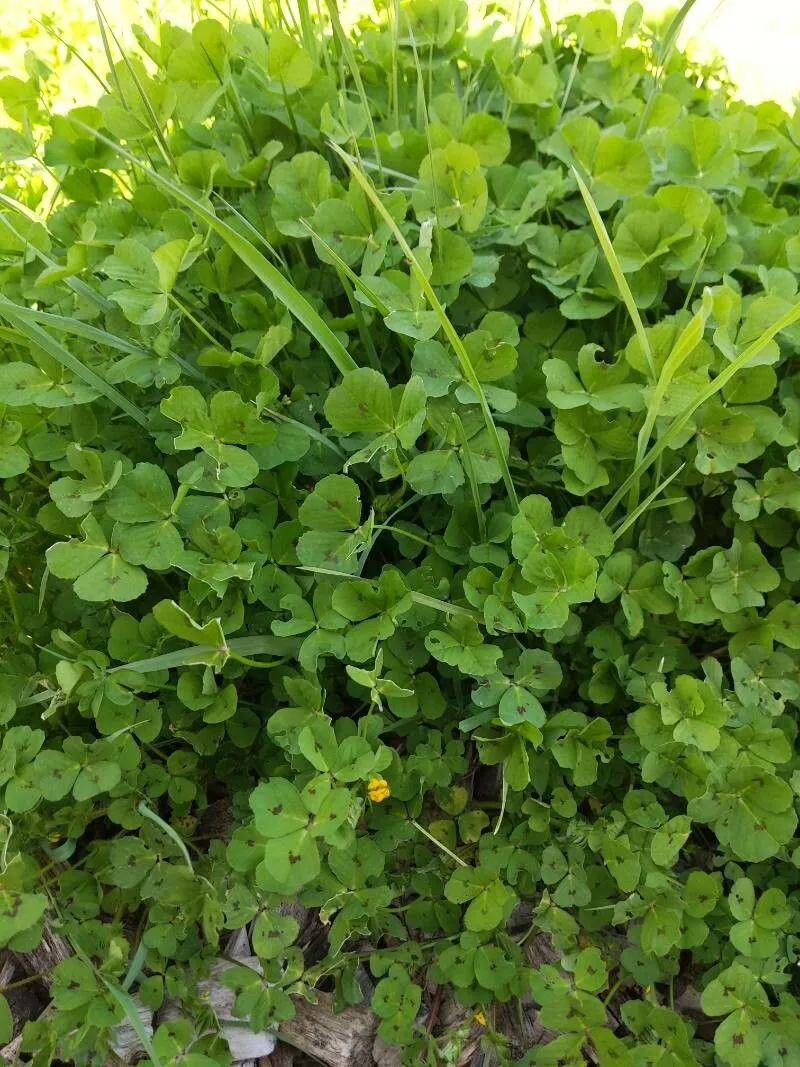
Author: (L.) Huds.
Bibliography: Fl. Angl.: 288 (1762)
Year: 1762
Status: accepted
Rank: species
Genus: Medicago
Vegetable: False
Observations: Canary Is., W. Europe to Medit and Caucasus
Spotted bur-clover, scientifically known as Medicago arabica, is a distinctive member of the Fabaceae family. This plant holds a notable presence across several geographical regions, including the Canary Islands, Western Europe, the Mediterranean, and the Caucasus. First documented in “Flora Anglica” in 1762 by William Hudson, spotted bur-clover has a storied botanical history.
Characterized by its trifoliate leaves, each leaflet typically displaying dark blotches or spots, Medicago arabica stands out in the landscapes it inhabits. The plant’s small, bright yellow flowers are arranged in clusters, eventually giving rise to its distinctive burr-like seed pods. These pods, covered with hooked spines, facilitate seed dispersal by attaching to the fur of passing animals or the clothing of humans, a clever adaptation enhancing its propagation.
Ecologically, spotted bur-clover plays a beneficial role. Like its Fabaceae relatives, it participates in nitrogen fixation, improving soil fertility by converting atmospheric nitrogen into a form usable by plants. This attribute makes it a valuable component of natural and agricultural ecosystems, contributing to soil health and productivity.
Historically and in contemporary settings, Medicago arabica has been utilized in various ways. Its ability to thrive in different environmental conditions makes it a useful forage crop for livestock. Additionally, its presence in disturbed soils and waste areas highlights its resilience and adaptability.
In summary, spotted bur-clover is a remarkable plant both ecologically and economically. With its distinctive markings, essential ecological role, and utility in agriculture, Medicago arabica continues to be an important species within its widespread range.
Lav: ar
Deu: arabischer schneckenklee
Eng: burclover, southern burr clover, spotted bur medick, spotted bur-clover, spotted burclover, spotted burrclover, spotted medic, spotted medick, spotted-leaf medic, spotted burr-clover
Dan: plet-sneglebælg, plettet sneglebælg
Por: alfafa-de-folhas-manchadas
Est: araabia lutsern
Swe: fläcklusern
Nld: gevlekte rupsklaver
Cat: herba de la taca
Fra: luzerne d’arabie, luzerne maculée, luzerne tachée, luzerne tachetée
Ita: medica maculata
Ces: tolice arabská
Spa: trébol de carretilla, trébol manchado
Cym: llys y meheryn, maglys amrywedd, maglys brith, meillion calfari, meillion gragenog
Nob: flekksneglebelg
Nno: flekksnigleskolm
Gla: meidic bhreac
Kat: იონჯა
En: Spotted bur-clover, Spotted medic, Spotted medick, Spotted-leaf medic, Burclover, Spotted Bur Medick, Spotted Burclover, Southern burr clover, Spotted burrclover, Spotted burr-clover, Calvary Clover, Cogweed
Ar: نفل (نَفَل)، نفله (نَفَلَه، نَفْله)، نفل (نِفِل)
Ca: Herba de la taca, Herba de taca
Zh: He ban mu xu
Cs: Tolice arabská
Da: Plet-sneglebælg, Plettet sneglebælg
Nl: Gevlekte rupsklaver
Et: Araabia lutsern
Fr: Luzerne d’Arabie, Luzerne maculée, Luzerne tachée, Luzerne tachetée
Ka: Იონჯა
De: Arabischer Schneckenklee, Gefleckter Schneckenklee
It: Medica maculata, Erba-medica araba
Ja: Montsuki-uma-goyashi
Lv: Ar
Nb: Flekksneglebelg
Nn: Flekksnigleskolm
Pt: Alfafa-de-folhas-manchadas
Gd: Meidic bhreac
Es: Trébol de carretilla, Trébol manchado, Medicago de Arabia
Sv: Fläcklusern
Cy: Llys y Meheryn, Maglys Amrywedd, Maglys Brith, Meillion Calfari, Meillion Gragenog
Taken Oct 30, 2021 by Guacimara Calle (cc-by-sa)
Taken Nov 24, 2021 by adele (cc-by-sa)
Taken Mar 10, 2022 by Michel AMBROISE (cc-by-sa)
Taken Sep 1, 2017 by 1 (cc-by-sa)
Taken Apr 5, 2018 by 1 (cc-by-sa)
Taken Apr 16, 2022 by Darren Giddins (cc-by-sa)
Taken Apr 28, 2021 by Boumlik Messaïli (cc-by-sa)
Taken Apr 16, 2022 by Gaël Covain (cc-by-sa)
Taken Apr 23, 2018 by Fejul Xeto (cc-by-sa)
Taken Apr 27, 2018 by Juan I Deán (cc-by-sa)
Taken Apr 19, 2022 by Gaël Covain (cc-by-sa)
Taken Mar 25, 2021 by Pietro Brignoli (cc-by-sa)
Taken Apr 28, 2021 by Boumlik Messaïli (cc-by-sa)
Taken Apr 16, 2022 by Gaël Covain (cc-by-sa)
Taken Apr 8, 2022 by Tristan Jaton-Maria (cc-by-sa)
Taken Apr 15, 2004 by Photoflora – Benoit BOCK (©)
Taken Jan 19, 2014 by EOL − Linda Jo Conn (cc-by-nc)
Taken Apr 16, 2022 by Pierre LEON (cc-by-sa)
Taken Mar 31, 2021 by Llandrich anna (cc-by-sa)
Taken Mar 22, 2015 by Tela Botanica − Yoan MARTIN (cc-by-sa)
Taken Jun 6, 2019 by Carlos Villasante (cc-by-sa)
Taken Apr 10, 2021 by layal layal (cc-by-sa)
Taken Jun 11, 2013 by Tela Botanica − Emmanuel STRATMAINS (cc-by-sa)
Taken Jun 11, 2013 by Tela Botanica − Emmanuel STRATMAINS (cc-by-sa)
Taken May 23, 2015 by Tela Botanica − Yoan MARTIN (cc-by-sa)
Taken Apr 15, 2005 by Photoflora – Jean-Luc TASSET (©)
Taken May 15, 2007 by Photoflora – Jean-Luc TASSET (©)
Taken Jan 1, 1970 by Photoflora – L’Abbé COSTE (©)
Taken Apr 10, 2014 by EOL − Matteo Piccinini (cc-by)
Taken Apr 28, 2006 by Tela Botanica − Barbara MAI (cc-by-sa)
© copyright of the Board of Trustees of the Royal Botanic Gardens, Kew.
© copyright of the Board of Trustees of the Royal Botanic Gardens, Kew.
© copyright of the Board of Trustees of the Royal Botanic Gardens, Kew.
Growth habit: Forb/herb
Ph maximum: 8.0
Ph minimum: 7.5
Light: 8
Atmospheric humidity: 5
Soil nutriments: 6
Family: Myrtaceae Author: (F.Muell.) K.D.Hill & L.A.S.Johnson Bibliography: Telopea 6: 402 (1995) Year: 1995 Status:…
Family: Rubiaceae Author: Pierre ex A.Froehner Bibliography: Notizbl. Bot. Gart. Berlin-Dahlem 1: 237 (1897) Year:…
Family: Sapindaceae Author: Koidz. Bibliography: J. Coll. Sci. Imp. Univ. Tokyo 32(1): 38 (1911) Year:…
Family: Asteraceae Author: A.Gray Bibliography: Pacif. Railr. Rep.: 107 (1857) Year: 1857 Status: accepted Rank:…
Family: Fabaceae Author: Medik. Bibliography: Vorles. Churpfälz. Phys.-Ökon. Ges. 2: 398 (1787) Year: 1787 Status:…
Family: Aspleniaceae Author: (Cav.) Alston Bibliography: Bull. Misc. Inform. Kew 1932: 309 (1932) Year: 1932…